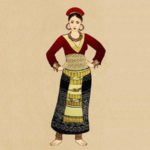The Hue Monuments Conservation Center recreated the Royal Audience ceremony of the Nguyen Dynasty on November 23rd, marking the completion of the three-year restoration of the Thai Hoa Palace. Over 100 staff members of the Center participated in this reenactment, bringing the ceremony to life in front of the palace.

During the ceremony, the officials of the Nguyen court were arranged in a specific order, with the heads of the ministries standing in the front row.
In the Nguyen Dynasty, the Royal Audience was a gathering between the emperor and his civil and military officials, held on the first and fifteenth day of every month, as well as on important occasions for the court.

The ceremony was conducted solemnly in front of the newly restored Thai Hoa Palace.
According to the records in the book “Dai Nam Thuc Luc,” in the fourth year of the Gia Long era (1805), the construction of the Thai Hoa Palace was completed in the seventh month of the autumn season. The palace and its courtyard were designated by the Gia Long court as the venue for the Royal Audience, which was held twice a month.

During the staged ceremony, an official of the Nguyen court read out the emperor’s edict to the assembled civil and military officials.
The Royal Audience ceremonies at the Thai Hoa Palace were ceremonial in nature, requiring the emperor and the officials to wear grand ceremonial attire. The officials performed five prostrations, which could be reduced to one or two depending on the occasion.

Inside the palace, high-ranking officials stood next to the golden throne in the main hall to hear the edict.

The Hue Royal Court Music troupe participated in the Royal Audience ceremony.
During the Nguyen Dynasty, after the opening of the court and the reading of the edict, the officials would offer congratulatory messages, and the emperor would host a banquet. Following this, the royal court music troupe would perform grand and minor musical pieces.

A court musician plays during the ceremony.
The organization of the Royal Audience ceremony was the responsibility of the Ministry of Rites, under the supervision of the officials of the Do Sat Vien (a court in charge of supervising and censoring other courts and officials).

Soldiers stood on both sides of the Thai Hoa Palace courtyard.
According to the “Chau Ban” of the Nguyen Dynasty, 990 soldiers were required to guard the Royal Audience at the Thai Hoa Palace. Additionally, there were 560 soldiers on duty at the various gates and palaces. From the time of King Dong Khanh onwards, French representatives also attended the Royal Audience.
The staged ceremony helped visitors and locals better understand the functioning of the Nguyen court.

After the ceremony, the officials exited the courtyard in the same order as they had entered, with the highest-ranking officials leading the way.
Whether it was a regular Royal Audience or an important court gathering, the ceremony never lasted more than an hour.

The Royal Audience and the reopening of the Thai Hoa Palace attracted hundreds of visitors to the Imperial City of Hue. After the ceremony, the palace opened its doors to the public after being closed for three years of restoration.
Reenactment of the Royal Audience ceremony of the Nguyen Dynasty in front of the Thai Hoa Palace. Video: Vo Thanh
A Glimpse into the Evolution of Vietnamese Women’s Traditional Attire
The rich cultural heritage of Vietnam is reflected in the diverse and vibrant array of traditional women’s attire. Join Bach Hoa Xanh on a journey through time as we explore the evolution of Vietnamese women’s fashion through the ages. From the elegant ao dai to the vibrant silk tunics, each piece tells a story of tradition, craftsmanship, and the unique beauty of Vietnamese culture. Stay tuned as we unravel the sartorial secrets of Vietnam’s women, offering a glimpse into the past and a celebration of the country’s rich heritage.



































